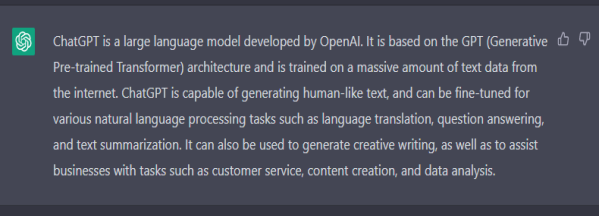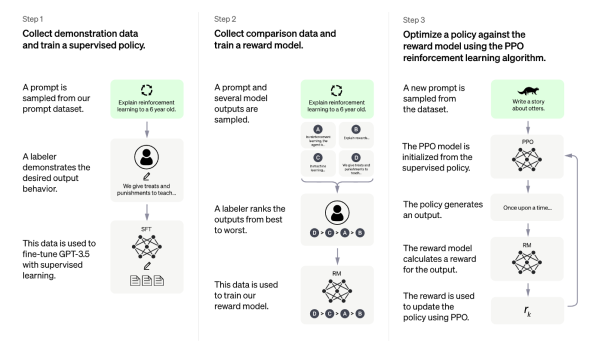There is no denying that AI has revolutionised our lives, making many things more accessible qucker. The way we live and work is quickly changing as a result of artificial intelligence (AI). In this article, we will look at the most recent advances in the field of artificial intelligence (AI) in the form of OpenAI’s viral bot ChatGPT and its use cases for businesses.
What is ChatGPT?
ChatGPT is a chatbot, that can respond to any prompts in plain English.
ChatGPT can explain quantum physics, design strategies, construct a workout routine, write a poem, explain codes, summarize information, explain complex topics, you name it, ChatGPT can do it. It is capable of doing everything you ask of it.

ChatGPT was created using GPT-3 (Generative Pretrained Transformer 3), the internet’s most well-known language processing AI model, with 175 billion parameters. In addition to ChatGPT, there are several readily available commercial models, such as
In terms of generation models, Large Language Models (LLMs) have very similar prompt engineering requirements. The content and structure of the generated text is influenced by these prompts, which are inputs used to direct the model’s text generation. Therefore, the majority of LLMs are trained using the same prompts.
OpenAI developed ChatGPT using Natural Language Processing technology. Using large datasets, ChatGPT learns how to perform natural language processing tasks and generates coherent, grammatically correct text through natural language processing.
How Does It Work?
In order to produce text that’s similar to what a human would write, ChatGPT uses deep learning. It is built on the GPT (Generative Pre-trained Transformer) architecture, which processes and produces text using a transformer neural network. As it was trained on a sizable body of text data, the model is able to comprehend the context and structure of language.
ChatGPT uses this pre-trained information to produce a response or extension of the text when presented with a prompt or a piece of text. It can produce text that often resembles that written by a person since the generated language is based on the patterns and correlations acquired during training.

ChatGPT Use Cases for Business
Here are some potential use cases for ChatGPT for your business.
If you’re considering getting a chatbot for your company, why not go for “work smart, not hard”? With ChatGPT, you can complete repetitive tasks without getting tired, saving you time and money. In terms of customer service, this could be really helpful. You don’t need to pay a costly person to answer brief inquiry questions about your business if computer bots can do it more cost-effectively and accurately.
ChatGPT excels in providing answers to frequently asked questions in a customer support setting. By fusing aspects of games and puzzles into the discussion, ChatGPT can also be used to “gamify” customer service, making it more entertaining and interactive.
When it comes to content creation, ChatGPT has a lot of creativity and power. It can generate written content like product descriptions, blog posts, and marketing copy.
Businesses can produce content customized for their particular niche and target audience with the help of ChatGPT. The business will benefit from higher rankings, increased engagement, and increased traffic to its website or page.
ChatGPT can also be used by businesses for language translation, allowing them to communicate with customers who speak several languages. Text from other languages can be translated with this, and the translations are very accurate.
Because the model can comprehend and analyze the details of several languages, ChatGPT’s language translation is highly accurate. Other machine translation systems may find it challenging to comprehend idiomatic phrases, colloquialisms, and other language-specific elements, yet it can accurately translate these. This may result in more accurate and natural translations, which could enhance the customer experience.
ChatGPT can summarize large texts or articles into shorter versions that are simpler to read and understand. It can also be used for email automation. The chatbot can instantly reply to incoming email leads and send out tailored email answers. Businesses that need to swiftly deliver critical information to their staff, clients, or partners would find this valuable.
Businesses can also use chatbots as virtual assistants powered by AI to make things easy. ChatGPT can act as your virtual assistant, available 24 hours a day, 365 days a year. This virtual assistant can be used to handle tasks, create reminders for upcoming events, deadlines, or projects, arrange meetings, and manage other responsibilities.
You can use ChatGPT to make your SEO process more efficient and effective. This frequently falls under content creation, but to truly convey how wonderful this can be, it needs its own title.
Businesses can use ChatGPT for SEO by producing original content that is SEO-optimized. It may be used to do keyword research by analyzing large amounts of text and discovering the most commonly used keywords.
Additionally, ChatGPT can be used for on-page SEO, meta description generation, and title tag creation.
Learn more about using ChatGPT for search engine optimization by checking out ChatGPT for SEO: 20 Ways to Leverage ChatGPT in your SEO Activities.
Businesses can use ChatGPT to speed up the sales process by using automated responses to client queries about price and product availability to provide personalized product suggestions to consumers based on their needs. Businesses including Walmart, Amazon, Alibaba, and Target have experimented with assisting customers with online orders and making product suggestions using chatbots powered by GPT-3.
ChatGPT can be used by businesses to generate interactive, branching narrative experiences for their customers, such as through a chatbot or voice-based assistant. This can be used to offer clients a unique and personalized experience and a fun and interesting way to communicate with a business.
Businesses can use ChatGPT to set up a virtual event host who can introduce speakers and give background information about them, conduct Q&A sessions by gathering and organizing participants’ questions and directing them to the right speaker, and offer event details like the time, place, and agenda.
For a business like a museum or a theme park, ChatGPT can act as a virtual tour guide who can answer queries and give information about the exhibits and activities. Visitors can communicate with the virtual tour guide through a chat interface by integrating the technology into a mobile app or website. Furthermore, based on the guests’ tastes and interests, the virtual tour guide can propose further exhibitions or attractions that they might find interesting.
With the rising popularity of conversational AI, organizations can profit from ChatGPT’s capacity to interpret and create natural language text, making it a valuable tool for automating and enhancing numerous language-based operations.
Challenges and Limitations of ChatGPT
Even though ChatGPT has a lot of advantages, there are certain limitations on how it may be used, including the following:
For instance, if you’re employing a chatbot to assist with customer support, you need to ensure that it is designed for every query that could arise and that it can handle them all.
Conclusion
ChatGPT is highly helpful for certain use cases since it can act as a foundation for other models. Someone may use ChatGPT as their foundation language model and train another custom model on top of it, for instance, if they want to develop a chatbot that only replies to particular inquiries. There is still much opportunity for advancement in the fields of natural language processing and language modeling.
ChatGPT works best for small teams with tight deadlines and a limited budget. ChatGPT could be excessive if you need to scale your project or if there are several individuals working on the same project at once. Other alternatives, such as cloud-based machine learning services, may be more suitable when you have a bigger project or team or need to scale up your project over time.
To learn more about ChatGPT, you can visit the websites https://chat.openai.com/chat and http://openai.com/blog/chatgpt. These sites provide information on how to access and interact with the model.

